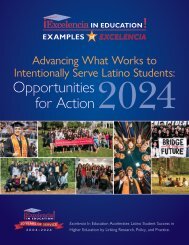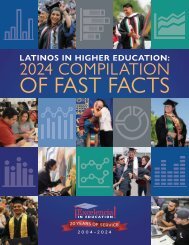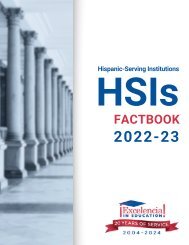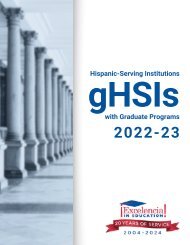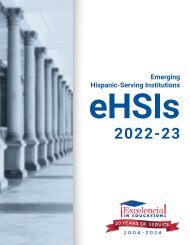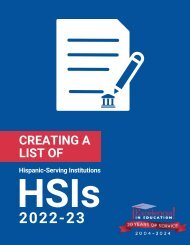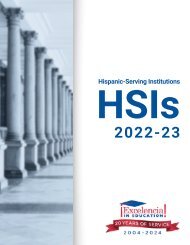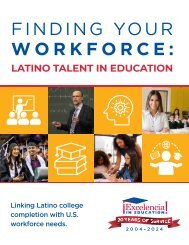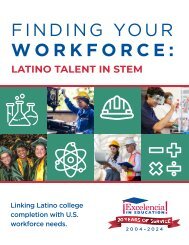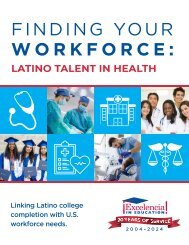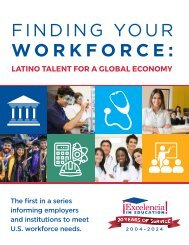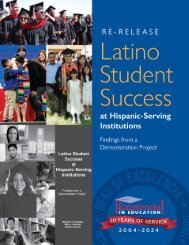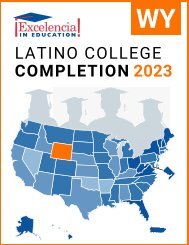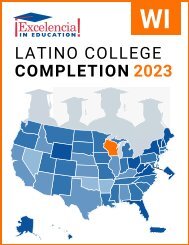Beyond Completion: Post-Completion Efforts at Hispanic-Serving Institutions
You also want an ePaper? Increase the reach of your titles
YUMPU automatically turns print PDFs into web optimized ePapers that Google loves.
BEYOND
COMPLETION:
POST-COMPLETION EFFORTS AT
HISPANIC-SERVING INSTITUTIONS
BEYOND COMPLETION:
POST-COMPLETION EFFORTS AT HISPANIC-SERVING
INSTITUTIONS
JULY 2022
AUTHOR:
Gabriel O. Bermea, Senior Research Analyst
ACKNOWLEDGMENTS:
This publication was developed with the generous support of the Strada Education Network and
benefited from review by Deborah Santiago, CEO, Emily Labandera, Director of Research, Russell
Nour, Strategic Data Fellow, and Cassandra Arroyo, Research Fellow, and input and perspectives
shared by representatives from seven Hispanic-Serving Institutions (HSIs): Austin Community College,
California State University-Fullerton, Long Beach City College, Texas State University, University of
Arizona, University of Illinois Chicago, and Wilbur Wright College.
Any opinions expressed in this report are the authors’ and do not necessarily represent the views of the
Strada Education Network, its officers or employees.
The author is solely responsible for the content, opinions, and any errors in this publication.
SUGGESTED CITATION:
Bermea, G.O. (July 2022). Beyond Completion: Post-Completion Efforts at Hispanic-Serving Institutions.
Washington, D.C.: Excelencia in Education.
For more information about this publication, contact: contact@edexcelencia.org
Excelencia in Education accelerates Latino student success in higher education by promoting Latino
student achievement, conducting analysis to inform educational policy, and advancing institutional
practices while collaborating with those committed and ready to meet our mission. Launched in 2004
in the nation’s capital, Excelencia is building a network of results-oriented educators and policymakers
to address the U.S. economy’s need for a highly educated workforce and engaged civic leadership. For
more information, visit: www.EdExcelencia.org.
©2022 by Excelencia in Education. All rights reserved.
BEYOND COMPLETION: Post-Completion Efforts at Hispanic-Serving Institutions
TABLE OF CONTENTS
FOREWORD .......................................................... 4
EXECUTIVE SUMMARY ................................................. 5
INTRODUCTION ...................................................... 6
BACKGROUND. ....................................................... 7
INTENTIONAL LANGUAGE ............................................. 8
FINDINGS ............................................................ 9
INSTITUTIONAL PROFILES
Austin Community College ............................................11
California State University-Fullerton .................................... 12
Long Beach City College ............................................. 13
Texas State University ............................................... 14
University of Arizona . . . . . . . . . . . . . . . . . . . . . . . . . . . . . . . . . . . . . . . . . . . . . . . . 15
University of Illinois Chicago .......................................... 16
Wilbur Wright College ............................................... 17
LESSONS LEARNED ................................................... 18
CREATE A TACTICAL POST-COMPLETION PLAN. ......................... 19
REFERENCES. ........................................................ 20
Excelencia in Education
3
FOREWORD
Students go to college to learn, get exposed to the world, and get a good job that can
make a positive difference for them, their families, and communities. That is a lot to
expect, and the role of institutions continues to evolve. Supporting students as they
earn their degree, being more student-centered and meeting students where they are
at academically to support their earning of a degree is already an evolution from the
traditional, outdated, and conventional expectation of institutions as places that sort
out students for success.
What happens after a student graduates? Is there a role for institutions or is it up
to the student, alumni network, or employers? Excelencia works with institutions
committed to intentionally becoming places where Latino students thrive. And in this
transformation, the institution can more intentionally serve all students, including the
communities in their service area. However, one area that gets less attention is the
role institutions have in supporting their graduates post-completion.
The institutions we are privileged to work with can articulate their role in educating lowincome,
first-generation, and students of color and they know their work does not end
with graduation. A quality education is part of a students’ journey to a job and career.
The seven institutions we worked with for this brief have accepted the challenge to
examine their data, practices, and leadership efforts to define the institutional role postcompletion.
They are committed to being intentional in their post-completion role to
support Latino and other post-traditional students. As part of this commitment, they
have engaged in robust and forward-thinking ways of considering how to leverage,
invest in, measure, scale, share, and promote the work that is having a positive impact
on success post-completion.
Deborah Santiago
Co-founder and CEO
4 BEYOND COMPLETION: Post-Completion Efforts at Hispanic-Serving Institutions
EXECUTIVE SUMMARY
Post-completion success for Latino students is a conscious campus conversation that is
gaining traction and support in a growing number of institutions. Excelencia in Education
collaborated and partnered with seven Hispanic-Serving Institutions (HSIs)* — Austin
Community College, California State University-Fullerton, Long Beach City College, Texas
State University, University of Arizona, University of Illinois Chicago, and Wilbur Wright
College — in exploring and examining post-completion success efforts. When looking
across the post-completion success narratives, Excelencia identified three strengths that
demonstrate the cohort’s efforts to advance post-completion success efforts with the
intention to serve Latino completers. These institutions showed strengths in:
• Offering culturally relevant institutional
practices designed to accelerate Latino
post-completion success.
• Providing custom measures and metrics to
track post-completion success outcomes.
• Demonstrating progress in closing postcompletion
success equity gaps for Latino
completers.
Additionally, partner institutions were asked to share
questions and areas of opportunity within their
respective institutions. Referencing these items,
Excelencia identified three main areas of growth
that institutions considered in their post-completion
success efforts. These institutions seek to:
• Deepen their knowledge of data collection
efforts and align measures to track postcompletion
success in both the short and
long term.
• Forge intentional connections with
employers and industries looking to
diversify their employment pool.
• Make the case to institutional leadership
for intentionally serving completers at
their institution.
This brief outlines evolving approaches and
discussions to post-completion success and
summarizes where institutions are in their efforts
to better understand post-completion success at
their respective institutions.
*HSIs are defined as accredited, degree-granting public or private nonprofit institutions of higher education with 25% or more
total undergraduate Hispanic full-time equivalent (FTE) student enrollment, which is noted in the Summary of Title V of the
Higher Education Opportunity Act, as amended in 2008. To be eligible for the “Developing HSIs Program,” the law further
requires that an HSI have a high enrollment of needy students and low core expenditures.
Excelencia in Education
5
INTRODUCTION
HSIs recognize their role is to prepare students for the workforce, offer support
to completers, and track completers after earning an educational credential at
their institution.
continue to make progress on Latino enrollment
and completion, Latino representation within
the workforce is expected to increase by 3%
every year. 6 In recognition of these changes,
HSIs are in a good position to expand their
strategy to advance Latino student success and
take active steps to create learning experiences
that promote workforce preparation and foster
Latino post-completion success.
Despite being disproportionately impacted by the
pandemic, Latinos in the workforce are projected
to reach 35.9 million and account for 78% of
net new workers by 2030. 1 By the end of the
decade, Latinos will make up 20% of the nation’s
workforce. 2 As the nation continues to recover
from the economic impact of the pandemic,
institutions intentionally focused on serving
their students saw an opportunity to rethink
their efforts to support Latino, and all, students
beyond degree completion.
Latinos’ college enrollment is projected to
increase over the next decade. 3 In tandem,
the number of Latino completers earning a
credential from an institution of higher education
is projected to increase. 4 Over the past five
years, Latino completers have made gains at all
certificate and degree levels. 5 As institutions
From October 2021 to March 2022, Excelencia
engaged seven HSIs representing two-year and
four-year institutions in Texas, California, Illinois
and Arizona in a project exploring and examining
post-completion success efforts. Participating
institutions included Austin Community College
(TX), California State University-Fullerton
(CA), Long Beach City College (CA), Texas
State University (TX), University of Arizona
(AZ), University of Illinois Chicago (IL), and
Wilbur Wright College (IL). Campus teams
were composed of three to five practitioners
representing areas such as career/workforce,
institutional research/effectiveness, alumni
relations, student affairs, and academic affairs.
These campus teams completed and shared
a robust internal assessment developed by
Excelencia of their post-completion success efforts.
Institutional efforts to better understand postcompletion
success often focus on workforce
readiness and preparedness — undergraduate
experiences that are often within the locus of
institutional control. However, as a cohort, these
HSIs are progressing beyond completion to meet
the needs of the nation’s economy and develop
strategies and practices that more intentionally
serve Latino completers.
6 BEYOND COMPLETION: Post-Completion Efforts at Hispanic-Serving Institutions
BACKGROUND
While Latino enrollment and completion continues to increase, there is still a growing gap of Latino
representation in high-paying jobs. Latino completion rates are not increasing fast enough to fully meet the
needs of today’s economy and increase the representation of Latino in high-paying jobs. 7 Latino representation
within the workforce is projected to increase by 3% per year, yet Latinos remain largely represented in
low-paying jobs. 8 These national trends in Latino student enrollment, completion and workforce present an
opportunity for Excelencia to dive deeper into understanding how institutions are intentionally responding to
meet the needs of their communities and economy through a Latino lens.
In 2007, Excelencia partnered with employers and institutions to
explore how institutions were expanding access to higher education
and benefiting low-skilled, immigrant Latino adults. The results of
that work emphasized employer engagement, connections with
community colleges, and results-oriented practices focused on
Latino workforce development as essential elements in creating
post-completion pathways for post-traditional Latinos. 9
In 2012, as a way of highlighting the importance of Latino
representation in high-paying jobs, Excelencia created a new
series of analysis identifying the top institutions graduating
Latinos at the certificate, associate, baccalaureate, and graduate
levels in specific fields of study that aligned with career clusters.
The work highlighted institutional strategies and practices for
successful pathways to increase access and interest in these
fields. 10 Additionally, Excelencia offered recommendations for
action to increase Latino retention and degree completion. As
Excelencia learned about institutional efforts to increase Latino
access, interest, retention, and completion, this research forged
another opportunity to learn about the impact on students
after earning their educational credential.
In 2018, Excelencia partnered with Gallup to conduct a national
survey of life outcomes among graduates. The study drew
from interviews with 14,320 college graduates from 12 HSIs
affiliated with the Excelencia in Action (E-Action) Network. The
results indicated graduates from Excelencia network institutions
believed they were prepared well for life beyond college. 11 This
was in part due to the strong support systems these graduates
experienced at their institution. These results prompted
Excelencia to further explore the types of support systems
institutions have in place to foster post-completion success.
In 2020, Excelencia partnered with four HSIs to learn more about
their efforts to intentionally prepare their Latino students for
the workforce. From this partnership, Excelencia identified five
strategies that framed how institutions approached their efforts
to promote post-completion success for their Latino students. 12
For example, the four HSIs embraced the commitment that
workforce preparation is an institution-level goal and requires the
institutions to adapt to changes within the workforce to better
prepare their students. To implement this commitment, these
institutions were scaling up hands-on learning and experiential
learning opportunities for their students. Additionally, workforce
efforts were revamped with data to inform strategy and
partnerships with local employers to meet the needs of the region
and offer graduates support transitioning from school to work.
Building upon past research and efforts, Excelencia partnered
with seven HSIs to continue exploring and examining the
institutions’ post-completion success efforts. This brief offers
findings to enhance an institution’s interest and ability to invest
in strategies to support students beyond completion, features
institutional strategies and practices, shares lessons learned,
and offers recommendations for action for institutions looking
to scale up their post-completion success efforts. Together,
these seven HSIs recognize their role goes beyond completion
by preparing students for the workforce, offering support
to completers, and tracking completers after earning an
educational credential at their institution.
Excelencia in Education 7
INTENTIONAL LANGUAGE
As Excelencia and our seven partner HSIs embarked on this project, the following terms
framed our work and offered a common language for us to develop our community of
common cause to explore and examine post-completion success efforts.
• Post-Completion is relating to or occurring
in the time following completion of an
educational credential (ex. bachelor, associate,
and certificate level).
• Completers is an inclusive term to refer
to Latinos who have earned an educational
credential (ex. bachelor, associate, and certificate
level) within an institution. Completers are not
cohort specific but rather a total sum of Latinos
who have earned their educational credential.
• Post-Completion Success refers to Latino
completers’ long term outcomes (ex. civic,
educational, well-being and workforce) within
an institutionally defined context and measure.
• Post-Completion Strategy refers to
institution level efforts intentionally designed to
support Latino completers as they enter into
society with an educational credential.
As I reflect on the two terms, post-completion is a milestone, a
marker, that offers a specific data point that the college can interrogate
to gain insight about that particular milestone. On the other hand,
completers elevates the “humanness” of our work. It is about the student
and calls for us to be aware, and intentional about the ways in which we
recognize our obligation to continue to serve our completers. The focus
becomes on the person, versus the milestone. Both of these concepts are
important to inform the work.
”
– Sonia De La Torre, Dean of Student Equity, Long Beach City College
8 BEYOND COMPLETION: Post-Completion Efforts at Hispanic-Serving Institutions
FINDINGS
POST-COMPLETION EFFORTS AT HISPANIC-SERVING INSTITUTIONS
STRENGTHS
As part of the pilot project, institutions brought
valuable insights into their own post-completion
success efforts. When looking across the Post-
Completion Success narratives, Excelencia
identified three strengths that demonstrate the
cohort’s efforts to advance post-completion
efforts with the intention to serve completers.
STRENGTH #1
Institutions Offer a Number of Culturally
Relevant Institutional Practices Designed to
Accelerate Latino Post-Completion Success.
Specifically, institutions offer wrap-around services
for completers, provide professional identity
affirming experiences, and provide intentional
and timely career readiness and job placement
experiences, programming, and services. From
lifetime access to career services to engaging in
an active post-completion network, institutions’
efforts demonstrated the importance of
extending services beyond completion to aid
completers in their continued educational and
professional development. Also, in recognizing
the intersectionality of Latino students, many
institutions elevated the importance of crafting
professional identity affirming experiences
(e.g., internships, career mentorship, research
assistantships) to aid in the development of social
capital, networking, career readiness, and more.
Finally, institutions provide intentional and timely
career readiness and job placement experiences,
programming, and services. Institutions reported
the importance of offering timely career
exploration, preparation and development services
and programs for Latino students. Looking beyond
the currently enrolled population, institutions
shared the need to connect Latino completers to
intentional resources that support their career
goals while also supporting their transition
between completion and becoming employed.
STRENGTH #2
Institutions Provide a Number of Custom
Measures and Metrics to Track Post-
Completion Success Outcomes.
Institutional post-completion measures and
metrics are mainly focused on salary, employment,
transfer to a four-year, military enlistment, and
continuation to graduate education. Additionally,
some institutions are now interested in considering
new aspirational measures and metrics (e.g., social
capital, applied competencies) to track postcompletion
success. Many institutions shared that
they were already collecting data on metrics and
measures related to post-completion success.
These custom metrics reflect the institution’s
intentional efforts to track post-completion
success through meaningful measures that highlight
the value of postsecondary education to both
students and the institution.
STRENGTH #3
Institutions Demonstrate Progress in Closing
the Equity Gaps of Post-Completion Success
Outcomes for Latino Completers.
Institutions within the cohort expressed a
resounding desire to be equity-minded in their
post-completion approach. The majority of
institutions analyzed the data disaggregated by
race/ethnicity to determine whether equity gaps
existed on their campuses. Some institutions
report equity gaps among various outcomes
(e.g., salary, employment, internships); however,
in some cases, the gaps are not as large as some
might assume. Finally, some institutions report
that Latino students also achieve higher rates in
transfer outcomes.
Excelencia in Education
9
AREAS OF GROWTH
As part of the pilot project, partner institutions
were asked to share questions and areas of
opportunity within their respective institutions.
Referencing these items, Excelencia identified three
main areas of growth that institutions considered in
their post-completion success efforts.
AREA OF GROWTH #1
Institutions Seek to Deepen Their
Knowledge of Data Collection Efforts and
Align Measures to Track Post-Completion
Success in Both the Short and Long Term.
As institutions considered their current metrics
and measures, many became aware that their
measures did not reflect their emerging ideas
of post-completion success. For example, some
institutions in the cohort are now interested
in considering new measures (e.g.,. social
capital, applied competencies) to track postcompletion
success. Institutions expressed the
importance of increasing the data capacity of
their institution. Specifically, institutions were
interested in strengthening their post-completion
success data collection methods. Additionally,
institutions shared their intention to increase
data collection methods and reporting via
workforce dashboards, prioritize race/ethnicity
in service provisions, and acquire more data to
enhance their understanding of post-completion
outcomes. A variety of data sources and methods
were shared among the cohort. From institutional
surveys to national data sets, data sources and
methods provide an extremely limited view
on post-completion outcomes; however, this
presents an opportunity to consider strategies to
more intentionally scale up data collection and
analysis. Finally, to get a fuller picture, institutions
are taking active steps to collect, mine, analyze,
track and link post-completion data and data
sources to demonstrate post-completion
outcomes for Latino completers and posttraditional
completers.
AREA OF GROWTH #2
Institutions Seek to Make Intentional
Connections With Employers and Industries
Looking to Diversify Their Employment Pool.
Institutions shared the importance of expanding
partnerships with local workforce investment
boards (WIB). Additionally, institutions reported
the importance of engaging in ongoing training
opportunities tied to industry certifications and
degrees. Also, institutions expressed continuing
transfer pathway partnerships with other
institutions as a way to strengthen post-completion
success for Latino students. Finally, institutions’
intentional efforts to offer and expand programs of
study relevant to today’s workforce and develop key
partnerships across industry organizations highlights
the expansion of post-completion pathways.
AREA OF GROWTH #3
Institutional Representatives Seek to Make the
Case to Institutional Leadership for Intentionally
Serving Completers at Their Institution.
With institutional resources focused on recruitment
and completion, many institutions saw this as an
opportunity to be more inclusive in their campus
dialogue around student success. Institutions,
especially community colleges, expressed what
fully constitutes completion on their campus
is being explored as they work to define postcompletion.
However, many institutions shared
working definitions of post-completion success.
To that end, institutions expressed a need
to “make a case” for post-completion as an
institutional priority to their campus leadership.
Institutions asked about approaches to including
post-completion into strategic plans, expanding
resources to include post-completion, and
increasing institutional capacity to support postcompletion
data collection and assessment efforts.
These three areas of growth highlight the
authenticity of their post-completion efforts while
also demonstrating where institutions are in their
efforts to better understand post-completion
success at their respective institutions.
10 BEYOND COMPLETION: Post-Completion Efforts at Hispanic-Serving Institutions
AUSTIN COMMUNITY COLLEGE
INSTITUTIONAL
PROFILE
Seal-Certified Institution | Austin, TX | Public, 4-Year | Hispanic-Serving Institution 13
28,882 UG Enrollment | 39.3% Latino Enrollment | 4,351 UG Completion | 36.1% Latino Completion 14
DEFINITION OF POST-COMPLETION SUCCESS 15
Austin Community College’s (ACC) Post-Completion Success definition includes “(1) transfer to a fouryear
institution (2) obtain a job in the field of study (3) complete an associate degree or certificate or (4)
transfer to another 2-year institution (core complete) or completed prerequisites for special admissions
programs. Additionally, ACC is deciphering a strategic way to measure post-completion success for
students wanting to learn skills, change in careers, or other student intent goals.”
POST-COMPLETION SUCCESS DATA SOURCES AND MEASURES 15
• Texas Unemployment Insurance (UI) Wage Data to allow ACC to determine if completers are
seeing improvements in wages after they attend ACC.
• Survey Completers to see where they are in their career, continuing education, and explore the
student’s viewpoint of how things are going with employment;
• EMSI (Economic Modeling Specialists Intl.) Reports that would allow ACC to access a larger
dataset of how completers are doing in the workforce post-completion.
POST-COMPLETION SUCCESS STRATEGIES 15
• Increase Institutional Capacity to Track Workforce Outcomes: Use Texas Workforce
Commission’s workforce dashboards to report program completers’ employment status, wage
improvement, and estimated median wages. The dashboards report results aggregated for completers
by program and award.
• Create Transfer Partnerships to Promote Post-Completion Degree Pathways: Funds through
an Equity in Transfer Initiative grant intended to promote transfer into high-wage pathways —
Engineering, Business, Nursing, Computer Science, Education, and Social Work — for students of
color and under-resourced, under-served students.
POST-COMPLETION SUCCESS PRACTICES 15
• Texas A&M University (TAMU) Engineering Academy has “one of the highest numbers of
completers for Latino engineers. Partnerships like the Texas A&M University Engineering Academy
assist in increasing underrepresented minorities in STEM degrees and increase not only ACC
credentials but also increase transfer into four-year institutions to earn a Bachelor’s degree.”
• Workforce Pathway Bachelor’s Degrees support “high-wage, in-demand careers. Two are
currently offered (RN to BSN; BAS in Software Development), and we will soon be launching a
Bachelors of Applied Technology in Manufacturing Engineering Technology. These are completion
degrees for students who have an associate degree, and recruiting efforts target Latino students.”
Excelencia in Education
11
INSTITUTIONAL
PROFILE
CALIFORNIA STATE UNIVERSITY –
FULLERTON
Seal-Certified Institution | Fullerton, CA | Public, 4-Year | Hispanic-Serving Institution 13
36,874 UG Enrollment | 48.0% Latino Enrollment | 9,688 UG Completion | 41.5% Latino Completion 14
DEFINITION OF POST-COMPLETION SUCCESS 16
California State University-Fullerton’s (CSUF) definition of post-completion success is focused on their
completer’s “ability to become intellectual, community, and economic leaders who shape the future.
Our institution approaches defining post-completion success by identifying the life-long skills and values
we seek to cultivate in our students, as articulated in our University Mission. Student’s workforce
outcomes and intellectual and community contributions to society are assessed frequently.”
POST-COMPLETION SUCCESS DATA SOURCES AND MEASURES 16
• EMSI (Economic Modeling Specialists Intl.) Data provides labor market data compiled from
various sources matched to a CSUF database of completers’ records to offer demographic, economic,
and occupational trends and outlook data locally and nationally.
• Undergraduate exit survey asks completers to identify their plans after graduation, the skills they
acquired to use post-completion, and their preparation to pursue their professional and/or personal goals.
• Strada Network Alumni Survey provides actionable insights around both completers’ overall
undergraduate experiences and the impact of that experience on their education-to-work journey.
This covers information on demographics, value of education experience, impact of education on
life and school affinity, skill development, current employment and graduate school status, career
satisfaction, impact of undergraduate education on employment, program/education information.
POST-COMPLETION SUCCESS STRATEGIES 16
• Develop an Institution-Wide Post-Completion Success Strategy that Meets the Needs of
Completers: CSUF is currently developing a unified approach to supporting Latino completers postcompletion.
Because CSUF is an HSI, their developing strategy will have a broad impact on their
Latino students, who are a large portion of their student population.
POST-COMPLETION SUCCESS PRACTICES 16
• Engineering Scholars Program is designed “to improve time to degree for undergraduate
engineering Latino students and improve the rate at which Latino students progress into graduate
programs. Results show that 21% of students participating graduated earlier than expected and 66%
of participants applied to graduate school.”
• I am First Program is designed “to target first generation students (many are Latino) postcompletion.
Provides access to employers/alumni, coaching sessions and networking.”
12 BEYOND COMPLETION: Post-Completion Efforts at Hispanic-Serving Institutions
LONG BEACH CITY COLLEGE
INSTITUTIONAL
PROFILE
Seal-Certified Institution | Long Beach, CA | Public, 2-Year | Hispanic-Serving Institution 13
21,634 UG Enrollment | 59.6% Latino Enrollment | 2,375 UG Completion | 58.9% Latino Completion 14
DEFINITION OF POST-COMPLETION SUCCESS 17
Long Beach City College (LBCC) “has adopted a multidimensional definition of post-completion success:
1) job placement prior to completion, 2) job placement after completion, 3) job advancement after
completion, and 4) transfer to a four-year.”
POST-COMPLETION SUCCESS DATA SOURCES AND MEASURES 17
• Salesforce to gather data on participation in work experience courses, clinical hours and/or
internships, workshops, industry engagement activities, and career readiness milestones.
• Exit Survey (to be developed) and LaunchBoard to gather data on job placement, wages, and
impact college experience had in job gains (e.g., social capital).
• Two-Year Post-Completion Survey (to be developed) to track employment updates, wage
increases, and application of skills gained in college.
• National Student Clearinghouse to track transfer patterns by number per year and/or cohort
model rate.
POST-COMPLETION SUCCESS STRATEGIES 17
• Create Social Capital Building Experiences for Latinx Students: LBCC intends to offer career
mentoring, year-long matching with professionals in the field of study and developing skills and
relationships with the workforce to increase social capital of Latino students.
• Partnership with Local Workforce Investment Boards: Develop ongoing training opportunities
tied to industry certifications and focus recruitment efforts on Latino students.
POST-COMPLETION SUCCESS PRACTICES 17
• Long Beach College Promise, a transfer pathway program, “is folded into the broader institutional
first-year experience and thus is resourced through FYE during the annual planning process (this
includes access to dedicated counselors, coaches, and other professionals. Case management by race/
ethnicity is integral to this program). Through a use of a racial equity lens in three years there has
been an increase in the number of Latino students that are participating in the Promise 2.0 program.”
• The PUENTE Project is “an inter-segmental program that is co-sponsored by the University of
California and the California Community College Chancellor’s Office, designed to increase the number
of educationally disadvantaged students who enroll in four-year colleges and universities, earn college
degrees and return to the community as mentors and leaders to future generations. The program is
interdisciplinary in approach, with writing, counseling and mentoring components. Over the last five years
the number of Puente students who successfully transfer has steadily increased (7 in 2017 to 16 2021).”
Excelencia in Education
13
INSTITUTIONAL
PROFILE
TEXAS STATE UNIVERSITY
Seal-Aspiring Institution | San Marcos, TX | Public, 4-Year | Hispanic-Serving Institution 13
33,193 UG Enrollment | 40.6% Latino Enrollment | 7,567 UG Completion | 37.3% Latino Completion 14
DEFINITION OF POST-COMPLETION SUCCESS 18
Texas State University’s emerging post-completion success definition “is designed to match the First
Destination Survey (FDS) from the National Association of Colleges and Employers, which tracks key
indicators such as enrollment in a program of continuing education, employment, salary, and military
service.”
POST-COMPLETION SUCCESS DATA SOURCES AND MEASURES 18
• The First Destination Survey is administered three times per year, to collect outcomes data
on completers’ employment and continued education as well as information about their college
experiences.
POST-COMPLETION SUCCESS STRATEGIES 18
• Acquire and Increase Post-Completion Success Data: Continued outreach to the entire
population of completers through the administration of the First-Destination Survey and increase
response rates.
• Intentionally Connect Latino Completers to Institutional Resources: Connect with Alumni
Relations to have Latino completers attend the Identity in the Workplace Workshops offered in the
spring by Career Services and engage in other key institutional resources designed for completers.
POST-COMPLETION SUCCESS PRACTICES 18
• Jobs4Cats (Handshake) is “an online job board service for current students and completers;
completers can get resume reviews, make one-on-one appointments, attend job fairs, and receive
professional development support.”
• Build Bridges to a Graduate Degree “is designed to provide support for undergraduate students
who are interested in applying to a graduate program at Texas State University. The initiative focuses
on learning how graduate school works, crafting a high-quality graduate school application, and setting
the stage for success in a graduate program. Recipients will receive $850, reimbursement for the GRE
or GMAT and their graduate program application fee. Plus, their culminating project is an application
to a Texas State graduate program.”
14 BEYOND COMPLETION: Post-Completion Efforts at Hispanic-Serving Institutions
UNIVERSITY OF ARIZONA
INSTITUTIONAL
PROFILE
Seal-Certified Institution | Tucson, AZ | Public, 4-Year | Hispanic-Serving Institution 13
34,659 UG Enrollment | 28.8% Latino Enrollment | 7,871 UG Completion | 25.0% Latino Completion 14
DEFINITION OF POST-COMPLETION SUCCESS 19
The University of Arizona’s definition of “post-completion success means that students are prepared for
a lifetime of opportunity aligned with their purpose and values and recognize their University of Arizona
education as valuable to achieving their career and personal goals.”
POST-COMPLETION SUCCESS DATA SOURCES AND MEASURES 19
• The First Destination Survey gathers immediate employment, continuing education, salary and
reputational self-reported data for Latino completers to create meaningful comparative analyses to
identify any significant gaps in equity of those outcomes when compared to peers.
• Graduate College National Science Foundation Survey is used to gather data on graduate level
post-completion outcomes such as work activities, salary, and demographic information.
• National Student Clearinghouse data on continuing education among those not completing the
First Destination Survey.
• Arizona Board of Regents Wage Tracking for public university graduates who earn wages in Arizona.
POST-COMPLETION SUCCESS STRATEGIES 19
• Disaggregate by Hispanic/Latino in Career-Related Engagements and Post-Completion
Outcomes to Determine Key Interventions that Support Success: For example, internships
and research experiences are leading indicators shown to have a multiplying effect on a Hispanic/
Latino student’s likelihood of reporting an employment or continuing education outcome immediately
beyond completion.
• Increase Institutions Engagement with Completers: Continue to reach out and offer career
support for completers up to one year after completion, increase access to Bear Down Network, and
engage the Hispanic Alumni Association.
POST-COMPLETION SUCCESS PRACTICES 19
• Latinx Faculty & Staff Association is “offers Latinx employees with opportunities to support
networking, mentoring, and community building. By supporting employees who are alumni and/or are
pursuing advanced degrees at the University of Arizona, the association supports networking and the
exchange of employment and professional development opportunities.”
• Accessible Micro-Internships “provide paid, accessible experiences with local community, campus
and employer partners to develop students’ human-centered research and design skills, as well skills
in collaboration, analysis and presentation.”
Excelencia in Education
15
INSTITUTIONAL
PROFILE
UNIVERSITY OF ILLINOIS CHICAGO
Seal-Certified Institution | Chicago, IL | Public, 4-Year | Hispanic-Serving Institution 13
21,702 UG Enrollment | 34.6% Latino Enrollment | 4,700 UG Completion | 28.4% Latino Completion 14
DEFINITION OF POST-COMPLETION SUCCESS 20
University of Illinois Chicago (UIC) approach to “defining post-completion success takes into account
national benchmarks for post-completion success of graduated students including job placement and
graduate/professional education, while also considering deeply the long-standing mission of UIC as an
urban-serving institution and our mission for equity and inclusion. While we recognize that there is a
focus on equity gaps in retention and graduation, our definition of post-completion success, especially
for longstanding contributors to our mission to support Latino students, is evolving to ensure students’
have a plan for post-completion success that contributes to multi-generational change.”
POST-COMPLETION SUCCESS DATA SOURCES AND MEASURES 20
• Academic Major Reporting is a new state law to provide students with information upon
declaration of their major including job placement data within 12 months after completion for a
completer who holds a degree in specific major.
• Equity Gap Tracking dedicated to lowering Latino equity gaps as they relate to overall postcompletion
success and increasing Latino graduate and professional school enrollment.
POST-COMPLETION SUCCESS STRATEGIES 20
• Embed Post-Completion Success Initiatives throughout Undergraduate Experience: Postcompletion
success at UIC begins from the moment students start their academic careers. Programs
and initiatives are designed to meet students at various points during their time at UIC, with a focus on
supporting timely graduation and encouraging post-completion simultaneously. Because at least a third of
their students are Latino, Latino students are able to take advantage of a wide variety of support initiatives.
• Assess Effectiveness of Advising and Career Planning Post-Completion: Through holistic
advising, Latin American Recruitment and Educational Services advisors help students engage in career
planning, while also planting the seed to encourage students to consider graduate school. Outcome
data include surveys on effectiveness of career planning and graduate school applicant numbers.
POST-COMPLETION SUCCESS PRACTICES 20
• Summer Undergraduate Research Program on Health Disparities (SURPHD) “provides
research opportunities to third and fourth year pre-medical undergraduate Hispanic/Latino or other
underrepresented minority students interested in minority health and health disparities.”
• Lead. Create. Change. Internship Program is designed “to expand students’ academic and
professional growth through project-based assignments and work-based learning with a focus on
environmental and social justice.”
16 BEYOND COMPLETION: Post-Completion Efforts at Hispanic-Serving Institutions
WILBUR WRIGHT COLLEGE
INSTITUTIONAL
PROFILE
Seal-Certified Institution | Chicago, IL | Public, 2-Year | Hispanic-Serving Institution 13
4,897 UG Enrollment | 61.0% Latino Enrollment | 905 UG Completion | 54.0% Latino Completion 14
DEFINITION OF POST-COMPLETION SUCCESS 21
As part of our project, Wilbur Wright College (WWC) is engaged in a campus-wide discussion regarding
their definition of post-completion success.
POST-COMPLETION SUCCESS DATA SOURCES AND MEASURES 21
• One-Year Graduate Follow-Up Survey: gathers data on employment, wages, and transfer.
• National Student Clearinghouse and the NSC Postsecondary Data Partnership: tracks
transfer patterns of students and disaggregated momentum indicators to track completion and postcompletion
success.
POST-COMPLETION SUCCESS STRATEGIES 21
• Move toward equity mindful, disaggregated data to understand and learn how to best serve
our Latino completers.
• Utilize disaggregated data to help inform evidence-based practices for Latino students at
each level of the decision-making process across the institution.
POST-COMPLETION SUCCESS PRACTICES 21
• Career and Professional Development Services “to develop best practice principles to work
with Latino students. Additionally, WWC works intentionally with Wright’s Continuing Education
Department and the Business Center to provide holistic ongoing personal and professional
development opportunities with Latino completers.”
• Culture of Post-Completion Support by “producing annual publication of transfer success stories
including students photos and stories from completers willing to come back to support other students
and share their experiences after completion.”
Excelencia in Education
17
LESSONS LEARNED
The seven HSIs within this brief demonstrate their commitment to post-completion
success through their intentional campus conversations around definitions, data sources,
measures, strategies, and practices. The collective efforts of these HSIs offer a few lessons
for institutions looking to make the case for post-completion success on their campus.
• Recognize post-completion success as a part of the student life cycle. Beginning with
recruitment and ending with post-completion success (rather than with completion), institutions
are rethinking and reevaluating their efforts to more intentionally serve and track outcomes of
completers. Institutions see their role as not just graduating students but also connecting completers
to meaningful work and positive life outcomes.
• Allocate time, resources, and staff to support post-completion success efforts. As institutions
continue to balance recruitment and completion, institutional leaders are shifting resources to support
post-completion success. Institutions leaders are listening to their campus leaders to identify data
sources, create intentional partnerships with employers, and invest in programs that prepare and
increase success after completion.
• Build up their post-completion data infrastructure. As institutions reflect upon their definitions
of post-completion success, institutions are thinking about their ability to track their outcomes
with reliable data sources. Institutions are investing time into the creation of dashboards, expanding
their social media analytics, and connecting with third parties to scale up their ability to track postcompletion
outcomes.
• Embrace innovative measures and metrics to track post-completion success. Thinking beyond
traditional post-completion measures (e.g., salary and job placement), institutions are interested in
tracking innovative post-completion measures such as social capital, economic mobility, Price-To-
Earnings Premium and more. These measures provide more insights into the impact an institution has
on a student post-completion and speak to the value add of their educational experience.
18 BEYOND COMPLETION: Post-Completion Efforts at Hispanic-Serving Institutions
CREATE A TACTICAL
POST-COMPLETION PLAN
For institutions looking to begin their post-completion journey, Excelencia identified
actionable steps institutions can take to better serve Latino completers and advance the
institution’s thinking towards intentional steps to examine and explore post-completion
success efforts.
• Ignite the Post-Completion Success Conversation. Institutions within this study assembled a
team of campus stakeholders to begin and/or continue the post-completion success conversation
on their campus. Made up of institutional leaders from alumni relations, career services, workforce
development, and more, an institutional team can lead the campus conversation by discussing postcompletion
definitions, deconstructing their definition and reconstructing it with intentional measures
to track the success of their Latino students after completion.
• Discover Post-Completion Success Data Sources. Institutions within this project were already
collecting post-completion success data at various levels through a number of data sources. For
institutions looking to learn more about their collection efforts, institutions can identify what postcompletion
success data is currently being collected, the frequency of data collection, where the data
is housed, and the responsible parties charged with gathering the data.
• Identify Post-Completion Success Key Performance Indicators. Institutions within this study
identified current and aspirational key indicators that aligned with their definition of post-completion
success. Institutions looking to articulate their impact post-completion are using such indicators to tell
their institutional story. These inclusive indicators articulate the value-add to the life of a completer
and the impact of an intentionally designed educational experience.
• Develop an Institution Level Post-Completion Success Strategy. Institutions within this project
identified or created their post-completion success strategies — actions and plans to achieve a larger
overarching goal. Institutional leaders looking to advance their post-completion work can take an
institutional-level approach to post-completion success to better serve their completers and identify
strategic areas to prepare, transition, and support their students after completion.
• Implement Post-Completion Success Evidence-Based Practices that Serve Completers.
Institutions within this study recognize their responsibility to offer services beyond completion to aid
completers in their continued educational and professional development. Going beyond the milestone
of graduation, institutional leaders looking to advance their post-completion efforts see completers as
an essential population to scale up efforts and programs to intentionally engage them in experiences
that foster professional development, career advancement, and personal well-being.
Excelencia in Education
19
REFERENCES
1 Dubina, K. (2021). Hispanics in the Labor Force: 5 Facts. (2021,
September 15). U.S. Department of Labor Blog. https://blog.
dol.gov/2021/09/15/hispanics-in-the-labor-force-5-facts.
2 Ibid
3 Excelencia in Education. (2022). Latino College Enrollment:
Past, Current, and Projections. Washington, D.C: Excelencia in
Education.
4 Excelencia in Education. (2022). Latinos and College Completion:
2019-2020. Washington, D.C: Excelencia in Education.
5 Ibid
6 Excelencia in Education. (2015). Latinos in the Workforce.
Washington, D.C: Excelencia in Education.
7 Excelencia in Education. (2020). Latino College Completion:
United States. Excelencia in Education. Washington, D.C.
8 Excelencia in Education. (2015). Latinos in the Workforce.
Washington, D.C: Excelencia in Education.
9 Gershwin, M., Coxen, T., Kelley, B., & Yakimov, G. (2007).
Building Tomorrow’s Workforce: Promoting the Education &
Advancement of Hispanic Immigrant Workers in America. Ann
Arbor, Michigan: Corporation for a Skilled Workforce.
10 Santiago, D. & Soliz, M. (2012). Finding Your Workforce: The
Top 25 Institutions Graduating Latinos. Washington, D.C:
Excelencia in Education.
11 Excelencia in Education & Gallup. (2018). Examining Life
Outcomes Among Graduates of Hispanic-Serving Institutions,
2018 HSIs and Workforce Survey. Washington, D.C.
12 Martinez, J. & Santiago, D. (July 2020). Tapping Latino Talent:
How HSIs are Preparing Latino Students for the Workforce —
Covid-19 Update. Washington, D.C: Excelencia in Education.
13 Excelencia in Education. (2022). Hispanic-Serving Institutions
(HSIs): 2020-21. Washington, D.C: Excelencia in Education.
14 Excelencia in Education analysis using U.S. Department of
Education, National Center for Education Statistics (NCES),
Integrated Postsecondary Education Data System (IPEDS),
2020 Fall Enrollment, Completions, and Institutional
Characteristics Surveys.
15 Austin Community College. (2022) Post-Completion Success
Framework. Washington, D.C: Excelencia in Education.
16 California State University-Fullerton. (2022) Post-Completion
Success Framework. Washington, D.C: Excelencia in
Education.
17 Long Beach City College. (2022) Post-Completion Success
Framework. Washington, D.C: Excelencia in Education.
18 Texas State University. (2022) Post-Completion Success
Framework. Washington, D.C: Excelencia in Education.
19 University of Arizona. (2022) Post-Completion Success
Framework. Washington, D.C: Excelencia in Education.
20 University of Illinois Chicago. (2022) Post-Completion Success
Framework. Washington, D.C: Excelencia in Education.
21 Wilbur Wright College. (2022) Post-Completion Success
Framework. Washington, D.C: Excelencia in Education.
1156 15th St. NW, Suite 1001 • Washington, DC 20005
www.EdExcelencia.org




